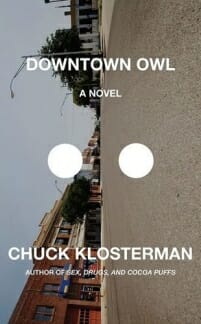
Cocoa Puffs fiend successfully tackles long-form fiction
Pop-culture addict Chuck Klosterman has polarized readers and critics with the unique brand of observational writing in his nonfiction books. His autobiographical glam-metal opus Fargo Rock City (2001) explored the effect of hair bands on a young man growing up in rural North Dakota. The 18 essays contained in Sex, Drugs and Cocoa Puffs (2003)—arguably his most popular book—cover The Sims, Billy Joel, Saved by the Bell, evangelical Christianity and much else. Killing Yourself to Live (2005) is a road-trip book about places where rock stars died, but also an examination of three girlfriends from Klosterman’s past and their impact on his life. And Chuck Klosterman IV (2006) is mainly a collection of previously published articles and columns.
Klosterman’s first novel, Downtown Owl, is set in the early ’80s and follows three main characters: Mitch, Julia and Horace—respectively, a smart, semi-secure high-school football player; a booze-loving 23-year-old teacher fresh out of the University of Wisconsin-Madison; and an elderly widower with a keen eye for truth and an affinity for coffee. We’re once again in small-town North Dakota, this time the fictional town of Owl. (Klosterman grew up on a farm in Wyndmere, N.D., and worked as a newspaper reporter in Fargo.)
Downtown Owl reads like a set of hyper-interesting short stories, and not only because it’s divided among the three major characters (who trade off chapters). Klosterman is adept at thinking up bizarre, somehow plausible scenarios that hook readers while pushing the story along. From a massive, $22,000 secret to a random-kissing drunkard to a legendary man who blew away two U.S. marshals with a rifle, Downtown Owl teems with vignettes, asides and secondary characters. They’re all carried along by unique literary devices Jonathan Safran Foer and Dave Eggers would be proud to employ, and Klosterman’s prose is a joy to read.
Everybody knows everything about everyone in Owl. Out-of-the-ordinary occurrences go down there just as they do anywhere else and, more often than not, each connects back somehow to our three characters. Meanwhile, Klosterman captures the hilarious and illogical essence of being a teenager while reveling in contradiction, cliché and absolutes, three of his favorite writing toys. Or, to put it in more Klostermaniacal language, all the characters of Downtown Owl become happier and sadder at the same time with the knowledge they have of each other. Along the way, they teach us that clichés are often based on fact (though not always), which is something everyone knows—except when they don’t. Klosterman’s style is as maddening to its detractors as it is intriguing to his followers; it wholly invokes Walt Whitman’s line, “Do I contradict myself? / Very well, then, I contradict myself. (I am large, I contain multitudes.)”
Downtown Owl is the Seinfeld of novels. It’s a book about nothing. The characters are quirky, funny, interesting and, sometimes, just as loathsome as Jerry and the gang. Conflicts arise, but rarely are they resolved or even monstrously consequential. Mitch hates his football coach. Mitch’s football coach hates his own life. Julia gets drunk, pining for a man she’ll never have. Horace drinks coffee with his friends and misses his dead wife. The rumor mill gets two students into a fight, but fisticuffs never occur. A yawnfest? Hardly. Like Seinfeld, the novel is wildly entertaining. Seemingly unimportant scenes build an intricate backdrop for an ending where the slate is essentially wiped clean.
Klosterman’s transition to the novel form is pretty seamless overall, peppered with hilarious dialogue, solid character development and those unorthodox literary devices. (In an early chapter, instead of high schoolers displaying their thoughts through a perfunctory conversation, Klosterman breaks them down into 22 individual entries, each its own specific desire or thought from a specific student at that specific moment. Samples: “Sleeping” and “that one eighth grader with the insane tits.”) And while his characters don’t obsess over pop culture as Klosterman has in past works, he still uses plenty of era-appropriate musical touchstones (ZZ Top, Karen Carpenter, Van Halen, etc.) in humorous music-dork fashion.
As for Mitch, Julia and Horace—they learn a few things about themselves and those around them. As small-town tension escalates, things feel predictable at first, but they finish unpredictably. Indeed, by story’s end, downtown Owl—which never was the same—never will be again.